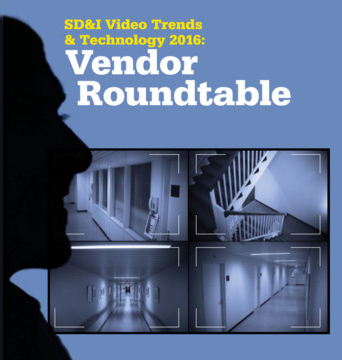Vendor Roundtable
Video surveillance has long been one of the most rapidly changing technologies on the security
landscape; and as security dealers and integrators search the ISC West show floor for the latest products and technologies, it can be a bit overwhelming.
Thus, the editors of SD&I felt that our annual Video Trends & Technologies issue should fall during the show in 2016. 
From resolution to storage to installation, these experts have it covered. Here’s what they had to say:
THE PANEL
- Steve Carney, Sr. Director Product Marketing, Video and Integration Platforms, Tyco Security Products
- Allen Chan, Senior Product Manager, Sony
- Dan Cremins, Global Leader of Product Management, March Networks
- Francis Lachance, Director of Product Management, Genetec Inc.
- Tom Larson, Director of Sales and Engineering, BCDVideo
- Scott Schafer, Executive Vice President, Arecont Vision
- Dr. Mahesh Saptharishi, Chief Technology Officer, Avigilon
- Uma Welingkar, Vice President of Product Management, 3VR
As dealers and integrators walk the ISC West show floor (often with their end-user customers), what differentiating product lines or features from video vendors should they be looking for or pointing out to customers?
Schafer: Being bombarded with visual imagery and product specifications in an environment like ISC West can make it a challenge to clearly determine the real difference among products. For cameras, canned demos and show lighting are not real-world conditions. If you see several megapixel cameras with similar claims, follow up with the ones that interest you. Many camera manufacturers will agree to do a post-show test at your site. Have the cameras installed side-by-side, and compare two or more at the same time. You’ll often discover that cameras with the same megapixel rating can vary widely in image quality in real world conditions.
Lachance: With the increase in IT cyber-attacks, security software companies like Genetec and edge device manufacturers are taking the “Security-of-Security” very seriously in 2016. On the show floor at ISC West, dealers and integrators should definitely be asking exhibitors what their strategy is to assure solid encryption and authentication is in place; from the edge to the archive.
Cremins: Integrators and their customers should be looking for products from a business perspective. They need to ask themselves, “What are the issues my customer is trying to solve and how can video help them do that?” Once you have your customer’s business objectives identified, it is much easier to hone in on the products that could potentially help them solve those challenges. Walking the floor at ISC West is a great chance for integrators and their customers, to ask video vendors how their products can save organizations time or help them improve operations — and then get a demo to see it for themselves.
Chan: Most manufacturers now have 4K cameras, and these are capturing customers’ attention and imaginations; however, it is important to understand why they are not all created equal. For example, not all 4K cameras will have a lens that is optimized for 4K imaging, and many have poor minimum illumination ratings. These factors can greatly impact the quality of a 4K camera’s output. Be precise with performance questions and beware the “specmanship” game. As we all know, specs don’t necessarily translate to real-world performance.
Carney: Integrators should look for products that tear down the physical security discipline silo, because more and more end-user customers are looking to deploy unified access control and video systems.
Welingkar: From the standpoint of video management systems (VMS), attendees should be looking for significant advancements when it comes to search functionality. Using video analytics as the basis for search means that users can find relevant video based on key terms like colors, directions or demographic information. This speeds up investigations and makes it far more efficient when locating evidence.
What impact have so-called “price wars” and consolidation had on the video surveillance industry as a whole?
Chan: Consolidation in the security industry poses an interesting question as traditional camera makers purchase VMS companies and vice versa, which can force a buyer into a product due purely to short-term cost considerations. As the industry matures, it may also become more difficult for manufacturers to compete based solely on product innovation. Other factors such as pricing, reputation, technical support and channel strategy may start to become more important to success.
Carney: This is a natural and predictable trend as technology moves into a mature stage of its lifecycle. In this case, IP is maturing, prices are coming down and manufacturers are looking to add value by way of solutions to stave off price erosion. Manufacturers are seeing increased pressure to deliver value-added solutions. If a manufacturer cannot demonstrate value, then it will lose the sale to price.
Welingkar: Consolidation in the security industry has its pluses and minuses. On the plus side, customers looking for a single-vendor solution will be able to work with one vendor, which will simplify the purchasing and installation process. The minus is that consolidation tends to slow innovation, and by working with just one vendor, customers find themselves tied to a single vendors’ product release cycle. Price wars also impact profit for integrators and dealers. Lower prices have not necessarily been met with a commensurate increase in overall sales volume.
Larson: The end-customer continues to reap the benefits of these price drops and receives more value for their dollar, as more trusted brands are incorporated into the overall solution. The need to “buy on the cheap”, and all of the risk and potential liabilities associated with that, are gone. Customers are expecting quality, regardless of price.
Lachance: These price wars are a symptom of a larger change in the way businesses consume technology: customers want to own products on their own terms and maintain flexibility how they manage their technology investment lifecycle. Many customers no longer wish to ‘own’ technology in perpetuity, and would rather consume products in a more flexible and on-demand manner.
What do you think will be the “next big thing” for video surveillance,
from a trends or technology perspective?
Saptharishi: We see end-customers renewing their demands for a more simplified security infrastructure that is cheaper to install and easier to maintain. More server side capabilities will migrate to the edge and appliances (purpose built, turnkey storage and compute devices) will become more popular. Additionally, the emergence of simple, low-power connected sensors will provide metrics that can help organizations improve operational efficiencies, flag potential physical security threats and understand their demographics.
Welingkar: The next big thing for video surveillance is to move from traditional surveillance to real-time, predictive, machine-learned behavior that will help build preemptive alert systems. We expect to see crowd sourcing play a role in this because it allows for the collection and sharing of video data from private and public sources. This could be anything from a camera on the exterior of a building to video taken on a personal smart phone. The ability to correlate data from a vast number of sources will allow cities to be more proactive and provide their citizens with better information in emergency situations. Of course, the cloud will play an important role in this process as well.
Larson: Once customers start to really drive analytics use for business purposes then there will be another boom for more video surveillance, as it will have an associated effect on the retention length. Retail marketing will be one of the earliest of adopters.
Schafer: Multi-sensor megapixel panoramic camera technology will continue to obsolete PTZs and slash the need for large numbers of fixed-view single sensor cameras while delivering improved situational awareness. Expect to see more variations of multi-sensor cameras as they grow more specialized, feature-rich, and potentially less expensive.
Carney: Customers are starting to understand the risks involved with riding under the IT cyber umbrella. It only takes a momentary breach (i.e. a door left open) to compromise an IP device if that device is not cyber secure. Additionally, the market is moving away from isolated features as the industry matures into the aggregation of features. Think about mobile — why would a user want different mobile experiences or apps for video, intrusion and access control? Seamless combination will become a focus in the coming years.
Chan: Although widespread adoption is still several years away, 4K will almost certainly be the next imaging standard for security and surveillance applications. Just as in the broadcast or consumer markets, the transition from SD (standard definition) to HD is fully established, and now, the industry is moving toward 4K. In addition, as the sensitivity of imaging devices improves, we will start to see the availability of even higher resolutions for specific surveillance or security needs.
Lachance: The traditional tree-view of security devices is moving to a more graphical, map-based modality for monitoring security systems. A map-based view, with real-time location links and in-window video images will drive the future of how VMS, access control and physical IP security evolve.
Do you think the industry is on track to ultimately move away from localized video storage solutions and completely store video in the cloud? Is there a downside to this trend?
Cremins: I was recently speaking with two systems integrators whose companies specialize in providing video surveillance solutions to retail customers. One topic we discussed was exactly that — the wholesale adoption of cloud-based video surveillance. We all agreed that, while cloud technology has evolved to the point where it is now a viable alternative to other types of surveillance solutions, it is clear that not everyone is ready to store all their video in the cloud. Depending on the size of the organization and the IT infrastructure they have in place, some cloud-based solutions can actually be more expensive. One major consideration relates to the fact that streaming video to the cloud requires a significant amount of bandwidth. Additional bandwidth can certainly be purchased, but it is going to come at a cost. How long an organization needs to retain their recorded video is also a factor.
Larson: Most end-users are very sensitive to where their video is stored. By having the video in the cloud, they are not in control of its security. Hybrid cloud is a more realistic solution. With the cost of video storage decreasing, the cost savings of cloud diminish. We are seeing more and more instances of 60 days on premises, then cloud for archival. Cloud replaces tape more than localized storage in this circumstance.
Carney: In early ‘cloud-buzz’ days, providers were quick to say “we got it,” but the value being delivered was questionable. Today’s customers will only consider cloud if it delivers value, not because it is trendy. I do not expect security directors of larger enterprises to allow video to reside outside the enterprise for some time unless they have a private cloud.
Saptharishi: The rise of IoT has created the need for efficient architectures that distribute storage and computation. The cloud will play an important role in this rapidly evolving distributed sensor network, but will not be the only provider of computation or storage.
Welingkar: From the loss prevention side, one key factor driving interest in the cloud is having access to archived videos from any location. This is important for investigators who may be looking into incidents across different locations or over a longer range of time.
Schafer: Security departments are typically not early adopters as they are necessarily risk-adverse. The result is that most customers prefer proven solutions that are considered mainstream or wait until they see benefits so compelling that they can be convinced to move. Determining who will protect and manage remote video, and who will pay and maintain the network infrastructure to make it possible remains to be determined.
What product features are you getting the most demand for from the systems designer/installer perspective?
Carney: More and more attention is being paid to cybersecurity. The Sony hack has really had a lasting impression on enterprises with sensitive data. This is likely the next real technological battleground within the physical security industry.
Welingkar: Installers are increasingly asking VMS vendors for products that are easy to install and deploy. They want a system that can easily scale to handle any size of deployment, from a single camera to hundreds or thousands of cameras. The system also needs to be able to run multiple, complex analytics, if needed.
Schafer: Simplifying megapixel camera installation continues to be important. To address that, we introduced a utility software tool for setup and updates to our cameras. We have also continued to add physical features to make installation easier such as motorized remote focus and remote zoom, spring loaded bayonet mounts, and magnets that hold the enclosure in place while screwing it down in various models.
Saptharishi: We are currently seeing a demand for systems that are better integrated, from video analytics, to central monitoring, to access control. Systems designers and installers require more elegant end-to-end solutions that make their lives easier. Concurrently, these professionals want to simplify installation and maintenance, which can be achieved with all-in-one appliances.
Larson: The market has shifted away from generic servers and storage companies. Customers expect enterprise performance at this point. It is not a “box running my cameras” any longer. We believe that the end-customer is driving the demand and expectation for quality through their integrator.
LaChance: A growing demand from our dealers is a product that will come with straight-forward installation, a self-running set-up, and automated edge device and archive discovery.
Cremins: Integrations with third-party products, including IP cameras, access control systems and particularly point-of-sale and ATM transaction systems. POS and ATM system integrations involve more than overlaying the transaction text over video. It is a deeper integration that allows investigators to run exception reports and spot suspicious activity.
Chan: In addition to picture quality and resolution, integrators are increasingly asking about dynamic range, bandwidth, storage, ease of installation and reliability. Security applications require 24/7 operation, and you never know how the environment will change and impact image quality. This especially relates to color reproduction outdoors, as there are many types of light sources and large swings in color temperatures.
View the full story at securityinfowatch.com.


